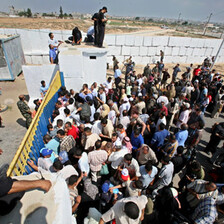Gaza Strip 28 July 2008

Rami Abdo with his nephew (Rami Almeghari)
Abdo, who is a representative of the stranded students and spokesman of the popular committee for breaking the Israeli siege, explained that most of the students have exhausted all efforts and coordination procedures through the Israeli authorities, the Palestinian Authority in Ramallah and all other concerned parties. However, these efforts have all been in vain.
“I have lost track. I am in a big state of confusion as to what I can plan, even in the short run. I am confused whether to stay in Gaza and continue what I am doing for the time being or [continue] working on attending classes in the UK,” Abdo added while mending a water-tap to his house’s garden.
Since last June, the Israeli occupation authorities have imposed a crippling blockade on Gaza, closing all border crossings after the now ruling Hamas party took control amidst factional fighting with the Fatah party of Palestinian Authority President Mahmoud Abbas. According to the Hamas authorities in Gaza, the Rafah crossing terminal shared with Egypt, which is the sole outlet for Gaza’s 1.5 million residents, has been reportedly reopened for only 27 days over the past 13 months.
Abdo recalled that “once I heard that the Rafah crossing terminal was reopened, I wrapped up my luggage quickly and said farewell to my parents, wife and daughter. But I returned back home the same day, as those who were allowed to enter were mainly patients and emergency cases. This has happened maybe three times during the past 13 months.”
The Erez crossing in northern Gaza, which is being run by the Israeli authorities, would be an alternative site from which the students could journey abroad. However, it remains closed and only a select number of students have been able to leave Gaza through Erez, and only through the assistance of foreign governments.
Several weeks ago, the US State Department intervened with Israeli authorities to allow seven Palestinians from Gaza who had been awarded prestigious Fulbright scholarships to enter Jerusalem for scheduled interviews at the US consulate. More recently, the US consular officials traveled to the Erez crossing to interview a different group of students who are supposed to study at various US universities. While this move was welcomed by Abdo, he said it was not enough.
“We appeal to the international community, especially to European governments to intervene to allow almost 670 students out of Gaza so they can achieve their basic right to an education,” Abdo implored.
International law, including the Universal Declaration of Human Rights, guarantees every individual the right to an education. However, despite all of Abdo’s appeals and those of his colleagues, Israeli authorities have not provided a clear-cut explanation why they can not leave Gaza. Nor has last month’s Egyptian-brokered ceasefire deal between Hamas and Israel changed the situation for these students.
“As an activist and as an ordinary Gaza resident, I can assure you that no concrete results of the ceasefire deal have been observed yet. We are still fighting for our basic rights, while there are many deaf ears and blind eyes around. We are going to organize a sit-in at the Rafah crossing terminal in southern Gaza very soon, to convey our message of protest before we lose hope.”
Rami Almeghari is contributor to The Electronic Intifada, IMEMC.org and Free Speech Radio News. Rami is also a former senior English translator at and editor-in-chief of the international press center of the Gaza-based Palestinian Information Service. He can be contacted at rami_almeghari A T hotmail D O T com.
Related Links
- Gaza’s 700 (and counting) stranded students, PCHR (5 June 2008)
- Gaza Fulbrights, small yet symbolic, IPS (2 June 2008)
- Academics urged to condemn US canceling of Gaza students’ Fulbright scholarships, PACBI (30 May 2008)
- BY TOPIC: Israel declares Gaza “enemy entity” (19 September 2007)





